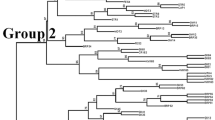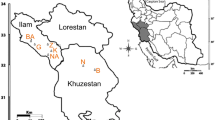Abstract
Using DNA fingerprint markers within species and populations of wild plants requires information on the relationship between fingerprint similarity and relatedness. We identified a hypervariable marker based on oliog(GATA)4-hybridization of DpnII-cut genomic DNA from Sea Lavender (Limonium carolinianum). Banding patterns were somatically stable and highly variable among unrelated individuals. Band molecular-weight sizing errors (as a percent of band molecular weight) were estimated at 0.44%±0.003 within gels and 0.76%±0.964 between gels. Band sizing errors defined a 99% confidence bin of ±0.95% (1.90% total) of molecular weight. Band-sharing estimates were based on this bin size and on variance estimates that compensate for non-independent comparisons. Band-sharing among nine unrelated individuals (θ) was 0.198±0.O11. Experimental pollinations designed to produce selfed, fulland half-sib progeny groups led to five selfed progeny groups and no outcrossed progeny (mean band-sharing, ovS=0.468±0.074). A linear regression between band-sharing (S) and relatedness (r) assuming 17% inbreeding was r=0.006+0.914*S (R2=0.973) and established the maximum amount of inbreeding. ovS(0.392±0.022) estimated from wild pollinated seeds from four maternal families was intermediate to unrelated individuals and experimental selfed progeny, giving evidence for mixed mating in wild plants. More extensive plant pedigrees with known levels of inbreeding will be needed to measure variation in the relationship between S and r among populations and families.
Similar content being viewed by others
References
Ausubel FM, Brent R, Kingston RE, Moore DD, Seidman JG, Smith JA, Struhl K (1993) Current protocols in molecular biology. Greene Publishing Associates and Wiley-Interscience, New York
Baker HG (1953) Dimorphism and monomorphism in the Plumbaginaceae. II. Pollen and stigmata in the genus Limonium. Ann Bot 67:433–445
Budowle B, Giusti AM, Waye JS, Baechtel FS, Fourney RM, Adams DE, Presley LA, Deadman HA, Monson KL (1991) Fixed-bin analysis for statistical evaluation of continuous distributions of allelic data from VNTR loci, for use in forensic comparisons. Am J Hum Genet 48:841–855
Butler MA, Templeton AR, Read B (1994) DNA fingerprinting in Speke's gazelle: a test for genetic distinctness, and the correlation between relatedness and similarity. Mol Ecol 3:355–361
Doyle JJ, Doyle JL (1987) A rapid DNA isolation procedure for small quantities of fresh leaf tissue. Phytochem Bull 19:11–15
Falconer DS (1989) Introduction to quantitative genetics. 3rd edn. Longman, London
Gilbert DA, Packer C, Pusey AC, Stephens JC, O'Brien SJ (1991) Analytical DNA fingerprinting in lions: parentage, genetic diversity, and relatedness. J Hered 82:378–386
Galbraith DA, Boag PT, Gibbs HL, White BD (1991) Sizing bands on autoradiograms: a study of precision for scoring DNA fingerprints. Electrophoresis 12:210–220
Haig SM, Belthoff JR, Allen DH (1993) Examination of population structure in red-cockaded woodpeckers using DNA profiles. Evolution 47:185–194
Heery DM, Gannon F, Powell R (1990) A simple method for subcloning DNA fragments from gel slices. Trends Genet 6:173
Jung C, Pillen K, Frese L, Fähr S, Melchinger AE (1993) Phylogenetic relationships between cultivated and wild species of the genus Beta revealed by DNA “fingerprinting.” Theor Appl Genet 86:449–457
Kuhnlein U, Zadworny D, Dawe Y, Fairfull RW, Gavora JS (1990) Assessment of inbreeding by DNA fingerprinting: development of a calibration curve using defined strains of chickens. Genetics 125:161–165
Luteyn JL (1990) The Plumbaginaceae in the flora of the southeastern United States. Sida 14:169–178
Lynch M (1988) Estimation of relatedness by DNA fingerprinting. Mol Biol Evol 5:584–599
Lynch M (1991) Analysis of population genetic structure by DNA fingerprinting. In: Burke T, Dolf G, Jefferies AJ, Wolff R (eds) DNA fingerprinting: approaches and applications. Birkhauser Verlag, Basel, Switzerland, pp 113–126
Mak Y-M, Ho K-K (1993) Use of polyethelene glycol for purification of DNA from leaf tissue of woody plants. BioTechniques 14: 735–736
Mannen H, Tsuji S, Mukai F, Goto N, Ohtagaki S (1993) Genetic similarity using DNA fingerprinting in cattle to determine relationship coefficient. J Hered 84:166–169
Nybom H (1991) Applications of DNA fingerprinting in plant breeding. In: Burke T, Dolf G, Jefferies AJ, Wolff R (eds) DNA fingerprinting: approaches and applications. Birkhauser Verlag, Basel, Switzerland, pp 294–311
Nybom H, Hall HK (1991) Minisatellite DNA ‘fingerprints’ can distinguish Rubis cultivars and estimate their degree of relatedness. Euphytica 53:107–114
Packer C, Gilbert DA, Pusey AE, O'Brien SJ (1991) A molecular genetic analysis of kinship and cooperation in African lions. Nature 351:562–565
Piper WH, Rabenold PP (1992) Use of fragment-sharing estimates from DNA fingerprinting to determine relatedness in a tropical wren. Mol Ecol 1:69–78
Rave EH, Fleischer RC, Duvall F, Black JM (1994) Genetic analyses throught DNA fingerprinting of captive populations of Hawaiian geese. Conservation Biol 8:744–751
Riscn NJ, Devlin B (1992) On the probability of matching DNA fingerprints. Science 255:717–720
Sambrook J, Fritsch EF, Maniatis T (1989) Molecular cloning: A laboratory manual. Cold Spring Harbor Laboratory, Cold Spring Harbor, New York
Van Heusden AW, Van der Voort JR, Bachmann K (1991) Oligo-(GATA) fingerprints identify clones in asexual dandelions Taraxacum (Asteraceae). Fingerprint News 3:13–15
Weir BS (1992) Independence of VNTR alleles defined as fixed bins. Genetics 130:873–887
Weising K, Beyermann B, Ramser J, Kahl G (1991a) Plant DNA fingerprinting with radioactive and digoxigenated oligonucleotide probes complementary to simple repetitive DNA sequences. Electrophoresis 12: 159–169
Weising K, J Ramser, D Kaemmer, G Kahl,and JT Epplen (1991b) Oligonucleotide fingerprinting in plants and fungi. In: Burke T, Dolf G, Jefferies AJ, Wolff R (eds) DNA fingerprinting: approaches and applications. Birkhauser Verlag, Basel, Switzerland, pp 312–329
Weising K, Nybom H, Wolff K, Meyer W (1994a) DNA fingerprinting in plants and fungi. CRC Press, Boca Raton, Florida
Weising K, Ramser J, Kaemmer D, Kahl G (1994b) Multilocus DNA fingerprinting and genetic relatedness in plants: a case study with banana and tomato. In: Schierwater B, Streit B, Wagner GP, De Salle R (eds) Molecular ecology and evolution: approaches and applications. Birkhauser Verlag, Basel, Switzerland, pp 45–59
Westneat DF, Noon WA, Reeve HK, Aquadro CF (1988) Improved hybridization conditions for DNA ‘fingerprints’ probed with M13. Nucleic Acids Res 16:4161
Wolff R, Nakamura Y, Odelberg S, Shiang R, White R (1991) Generation of variability at VNTR loci in human DNA. In: Burke T, Dolf G, Jefferies AJ, Wolff R (eds) DNA fingerprinting: approaches and applications. Birkhauser Verlag, Basel, Switzerland, pp 20–38
Author information
Authors and Affiliations
Additional information
Communicated by p. M. A. Tigerstedt
Rights and permissions
About this article
Cite this article
Hamilton, M.B., Rand, D.M. Relatedness measured by oligonucleotide probe DNA fingerprints and an estimate of the mating system of Sea Lavender (Limonium carolinianum). Theoret. Appl. Genetics 93, 249–256 (1996). https://doi.org/10.1007/BF00225753
Received:
Accepted:
Issue Date:
DOI: https://doi.org/10.1007/BF00225753




